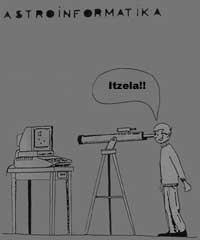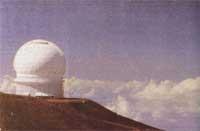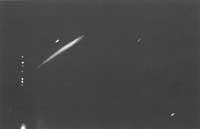Teaching of Astronomy (I)
1994/12/01 Sarasola Manech, Julen Iturria: Elhuyar aldizkaria
Introduction
With the new year, in the ASTRONOMY section we started a new battery of articles. On this occasion and as an introduction, I will give some explanations about the DIDACTICS OF ASTRONOMY and its surroundings (why astronomy?, how did it come about throughout history? what is your social interest? attracts young people? How?,... ). In the following articles we will work on PRACTICAL ASTRONOMY (how to build sunwatches?, how to orient the telescope?, how to identify stars on the mountain?, etc. ).
Permanent Astronomical Seminar

What about our team? We have spent almost ten years enjoying astronomy and teaching astronomy. We are a team of teachers and an open team. In this Permanent Seminar on Astronomy we met people from all corners of the Basque Country with different levels of learning. Our only intention is that, even in the short term, in our country, as in others (Catalonia, for example), astronomy (knowing the sky and its events and objects, observing, predicting, enjoying, etc.) extension to teaching, youth centers and cultural manifestations, recovering the place that formerly occupied.
On the other hand, from now on we will publish in this section the ASTRONOMICAL EPHEMERIS (see page 7), explaining the stars that will be visible from our box office in the current sky. We will also explain in a didactic way how these calculations are made.
A little history
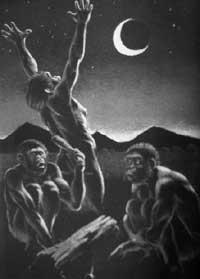
Although we do not know exactly how or where, we are convinced that no human being possessed an initial astronomical knowledge about his limited universe (time measurement, seasons of the year, orientation of urban, religious or sepulchral constructions, explanation of facts such as the eclipses of Sun and Moon, and, of course, the imagination about the size and appearance of the Universe). This knowledge has been transmitted in one way or another from parents to children, forming a historical record of the human being, and thanks to the science called archaeoastronomy is reaching us.
Two thousand five hundred years ago, the first peoples, fruit of market exchanges and with it exchanges between different cultures, expanded their limits of “universe vision” and became creators of a new philosophical way of thinking to explain this new universe. In this new philosophical conception, the world would no longer be, as can not be predicted according to the “desires” of the gods, done, Chaos. “Everything ordered,” Kosmosa, would be like a sort of “game regulation” or legislation to be found.
While the exchange between Aegean and the peoples living on the Ionian coast in ancient Greece remained free, a new culture was attempted following the following path: The first stellar record of Hipparchus, the measurement of the radius of the Earth of Eratosthenes, the Moon of Aristarchus and the first approximations of the size and distances to the Sun, the first hypotheses on the structure of matter (components of Tales, Anaximander, etc. ; the atom of Democritus…) and obvious technological development. Technological development freed man from the burden to get daily work out with his hands. From that time they were the first “teachers” and “students,” who sitting around or sitting on the stairs of the temple, would constitute the first type of school.

The authorities' devotion to domination, slavery, led these peoples to war and destroyed the roots of a cultured and prosperous society. We still have in the library of Alexandria a record of something that is witness to this short but happy time for the development of sciences and letters. Although in the fifth century it was irrationally burned and deteriorated. This record is sometimes the last staff of what Hypatia was to be the school of scientific thought. It explains that the woman astronomer and mathematician was burned to the fire, an action that reveals the freedom and culture of then.
Thanks to the spread of Arab culture, the Hellenic texts began to be translated into all languages and, together with their rich knowledge, they arrived in medieval Europe through the convents and abbeys that existed there. There they kept themselves and returned to Latin. These convents and abbeys “had to have schools attached”, as indicated by the expressive order of Charlemagne

Under the ideas of Aristotle and the Church the first European universities emerged (Paris, Bologna, Oxford, Cambridge and Salamanca). and XIII. for centuries to teach Trivium (grammar, rhetoric and logic of Latin) and Quadrivium (arithmetic, geometry, music and astronomy).
During the renaissance great advances were made in the knowledge of the universe (heliocentric system, invented telescope, etc.) the strict vision of conservative university institutions was broken. During this period, universities began to teach a new astronomy according to the knowledge of the time.
XVII. The twentieth century dismissed us from the publication of Isaac Newton’s book “Philosofiae Naturalis Principia Mathematica”, invented two centuries earlier. This book was a curious explanation of the laws of nature, since it associated what happened on the earth's surface (the apple jump) with the events of the sky (specifically the motion of the Moon). Since then, astronomical research and its teaching would not be separated.
Current situation
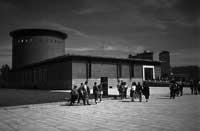
Until recently, in the Spanish state, higher education of astronomy as support for other disciplines (Nautical, Topography, Meteorology, etc.) or as a specialty, from the second cycle. It taught the pure mathematical formulation (for the calculation of orbits and angles of position; Celestial mechanics) or the theoretical description of models and their evolution (Astrophysics). The topics covered in the class never had a real follow-up from the observatory, at least if they did not do one on their own.
However, the teaching model has recently been modified. Astronomy works differently. Each specific topic includes all specialized subjects (Environment Physics, Cosmology, Astrophysics, Celestial Mechanics, Star Statistics, Optical Astronomy, Radioastronomy, Astrophotometry, Astrospectroscopy, Heliophysics, Planetary Geology, Exibiology, Astronautics, etc. ). At the same time, possibilities of observation and practical implications in research programs are sought.
Although in the Spanish state there are a dozen faculties that work Astronomy as a specialty of the second cycle (mainly islands of Barcelona, Madrid, Zaragoza, Valencia, Granada, Seville and the Canary Islands), in the new plan of studies of Physical Sciences, in the first cycle of all faculties, it is intended to implement the subject of Astrophysics.

Thanks to the demand for the teaching of astronomy at the basic levels (specifically in Secondary) and advanced research programs at the state level (Instituto Astrofísica de Canarias – I.A.C.-), the excellent opportunity it offers to study the horizon has turned the European Observatory of the South and is legally protected) and those at the international level (Hubble Space Telescopes, Telescopic Hope, Radiology.

Gai honi buruzko eduki gehiago
Elhuyarrek garatutako teknologia



